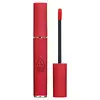What's inside
What's inside
 Key Ingredients
Key Ingredients

 Benefits
Benefits

 Concerns
Concerns

 Ingredients Side-by-side
Ingredients Side-by-side

Dimethicone
EmollientBis-Diglyceryl Polyacyladipate-2
EmollientHydrogenated Polyisobutene
EmollientTridecyl Trimellitate
EmollientPhenyl Trimethicone
Skin ConditioningIsohexadecane
EmollientCI 15985
Cosmetic ColorantHydrogenated Jojoba Oil
AbrasiveDimethicone Crosspolymer
Emulsion StabilisingIsostearyl Isostearate
EmollientParaffin
PerfumingMethylsilanol/Silicate Crosspolymer
Skin ConditioningCera Microcristallina
Emulsion StabilisingKaolin
AbrasiveMica
Cosmetic ColorantVinyl Dimethicone/Methicone Silsesquioxane Crosspolymer
Nylon-12
Polyethylene
AbrasiveCI 15850
Cosmetic ColorantSynthetic Wax
AbrasiveCI 77491
Cosmetic ColorantTriethoxysilylethyl Polydimethylsiloxyethyl Dimethicone
Skin ConditioningIsopropyl Titanium Triisostearate
EmollientCI 77499
Cosmetic ColorantPentaerythrityl Tetra-Di-T-Butyl Hydroxyhydrocinnamate
AntioxidantBenzyl Alcohol
PerfumingLimonene
PerfumingWater
Skin ConditioningPropanediol
SolventBenzyl Benzoate
AntimicrobialAnise Alcohol
PerfumingTocopherol
AntioxidantPelargonium Graveolens Extract
MaskingParfum
MaskingAlumina
AbrasiveDimethicone, Bis-Diglyceryl Polyacyladipate-2, Hydrogenated Polyisobutene, Tridecyl Trimellitate, Phenyl Trimethicone, Isohexadecane, CI 15985, Hydrogenated Jojoba Oil, Dimethicone Crosspolymer, Isostearyl Isostearate, Paraffin, Methylsilanol/Silicate Crosspolymer, Cera Microcristallina, Kaolin, Mica, Vinyl Dimethicone/Methicone Silsesquioxane Crosspolymer, Nylon-12, Polyethylene, CI 15850, Synthetic Wax, CI 77491, Triethoxysilylethyl Polydimethylsiloxyethyl Dimethicone, Isopropyl Titanium Triisostearate, CI 77499, Pentaerythrityl Tetra-Di-T-Butyl Hydroxyhydrocinnamate, Benzyl Alcohol, Limonene, Water, Propanediol, Benzyl Benzoate, Anise Alcohol, Tocopherol, Pelargonium Graveolens Extract, Parfum, Alumina
Dimethicone
EmollientCyclopentasiloxane
EmollientDimethicone Crosspolymer
Emulsion StabilisingDimethicone/Vinyl Dimethicone Crosspolymer
Skin ConditioningPolyglyceryl-2 Triisostearate
EmulsifyingIsododecane
EmollientCI 45410
Cosmetic ColorantCyclohexasiloxane
EmollientCI 15985
Cosmetic Colorant1,2-Hexanediol
Skin ConditioningDisteardimonium Hectorite
StabilisingPhenoxyethanol
PreservativeParfum
MaskingPEG-10 Dimethicone
Skin ConditioningTocopheryl Acetate
AntioxidantPropylene Carbonate
SolventCaprylic/Capric Triglyceride
MaskingHelianthus Annuus Seed Oil
EmollientCalendula Officinalis Flower Oil
MaskingRosa Canina Fruit Extract
AstringentRose Extract
Skin ConditioningDimethicone, Cyclopentasiloxane, Dimethicone Crosspolymer, Dimethicone/Vinyl Dimethicone Crosspolymer, Polyglyceryl-2 Triisostearate, Isododecane, CI 45410, Cyclohexasiloxane, CI 15985, 1,2-Hexanediol, Disteardimonium Hectorite, Phenoxyethanol, Parfum, PEG-10 Dimethicone, Tocopheryl Acetate, Propylene Carbonate, Caprylic/Capric Triglyceride, Helianthus Annuus Seed Oil, Calendula Officinalis Flower Oil, Rosa Canina Fruit Extract, Rose Extract
Ingredients Explained
These ingredients are found in both products.
Ingredients higher up in an ingredient list are typically present in a larger amount.
Ci 15985 is a dye made from petroleum. It is synthetically created and approved by the FDA for use in foods and cosmetics.
The color of this dye is orange/yellow.
This ingredient can be found in makeup, sun care, and skincare.
Learn more about CI 15985Dimethicone is a type of synthetic silicone created from natural materials such as quartz.
What it does:
Dimethicone comes in different viscosities:
Depending on the viscosity, dimethicone has different properties.
Ingredients lists don't always show which type is used, so we recommend reaching out to the brand if you have questions about the viscosity.
This ingredient is unlikely to cause irritation because it does not get absorbed into skin. However, people with silicone allergies should be careful about using this ingredient.
Note: Dimethicone may contribute to pilling. This is because it is not oil or water soluble, so pilling may occur when layered with products. When mixed with heavy oils in a formula, the outcome is also quite greasy.
Learn more about DimethiconeDimethicone Crosspolymer is a silicone created by modifying dimethicone with hydrocarbon side chains. Due to its large size, it does not penetrate skin. It is considered non-occlusive.
Dimethicone Crosspolymer is used to stabilize and thicken products. It also helps give products a silky feel.
Parfum is a catch-all term for an ingredient or more that is used to give a scent to products.
Also called "fragrance", this ingredient can be a blend of hundreds of chemicals or plant oils. This means every product with "fragrance" or "parfum" in the ingredients list is a different mixture.
For instance, Habanolide is a proprietary trade name for a specific aroma chemical. When used as a fragrance ingredient in cosmetics, most aroma chemicals fall under the broad labeling category of “FRAGRANCE” or “PARFUM” according to EU and US regulations.
The term 'parfum' or 'fragrance' is not regulated in many countries. In many cases, it is up to the brand to define this term.
For instance, many brands choose to label themselves as "fragrance-free" because they are not using synthetic fragrances. However, their products may still contain ingredients such as essential oils that are considered a fragrance by INCI standards.
One example is Calendula flower extract. Calendula is an essential oil that still imparts a scent or 'fragrance'.
Depending on the blend, the ingredients in the mixture can cause allergies and sensitivities on the skin. Some ingredients that are known EU allergens include linalool and citronellol.
Parfum can also be used to mask or cover an unpleasant scent.
The bottom line is: not all fragrances/parfum/ingredients are created equally. If you are worried about fragrances, we recommend taking a closer look at an ingredient. And of course, we always recommend speaking with a professional.
Learn more about Parfum